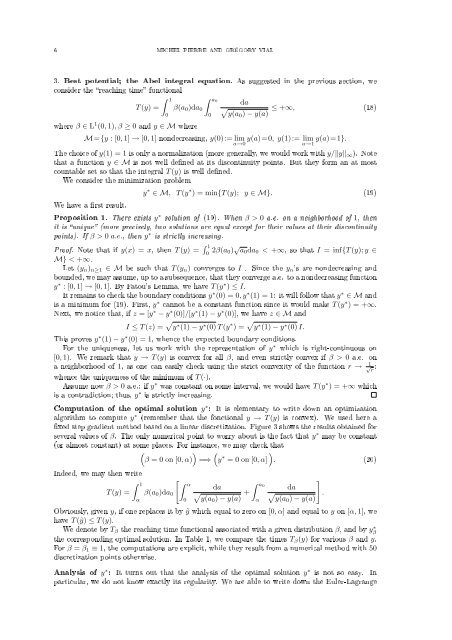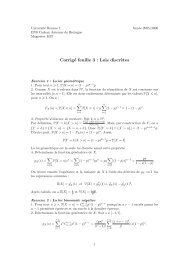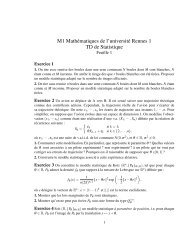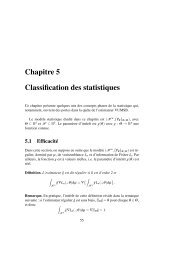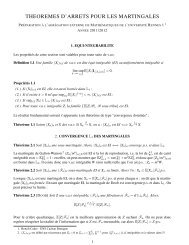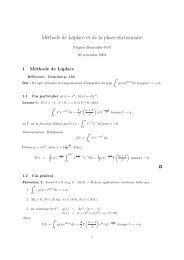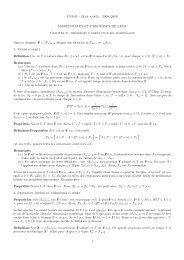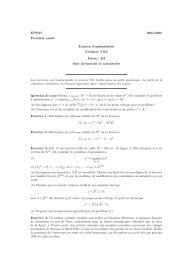best design for a fastest cells selecting process - ENS de Cachan ...
best design for a fastest cells selecting process - ENS de Cachan ...
best design for a fastest cells selecting process - ENS de Cachan ...
- No tags were found...
You also want an ePaper? Increase the reach of your titles
YUMPU automatically turns print PDFs into web optimized ePapers that Google loves.
6 MICHEL PIERRE AND GRÉGORY VIAL3. Best potential; the Abel integral equation. As suggested in the previous section, weconsi<strong>de</strong>r the reaching time functionalT (y) =∫ 10β(a 0 )da 0∫ a0where β ∈ L 1 (0, 1), β ≥ 0 and y ∈ M where0da√ ≤ +∞, (18)y(a0 ) − y(a)M={y : [0, 1] → [0, 1] non<strong>de</strong>creasing, y(0):= lima→0y(a)=0, y(1):= lima→1y(a)=1}.The choice of y(1) = 1 is only a normalization (more generally, we would work with y/‖y‖ ∞ ). Notethat a function y ∈ M is not well <strong>de</strong>ned at its discontinuity points. But they <strong>for</strong>m an at mostcountable set so that the integral T (y) is well <strong>de</strong>ned.We consi<strong>de</strong>r the minimization problemWe have a rst result.y ∗ ∈ M, T (y ∗ ) = min{T (y); y ∈ M}. (19)Proposition 1. There exists y ∗ solution of (19). When β > 0 a.e. on a neighborhood of 1, thenit is unique (more precisely, two solutions are equal except <strong>for</strong> their values at their discontinuitypoints). If β > 0 a.e., then y ∗ is strictly increasing.Proof. Note that if y(x) = x, then T (y) = ∫ 10 2β(a 0) √ a 0 da 0 < +∞, so that I = inf{T (y); y ∈M} < +∞.Let (y n ) n≥1 ∈ M be such that T (y n ) converges to I . Since the y n 's are non<strong>de</strong>creasing andboun<strong>de</strong>d, we may assume, up to a subsequence, that they converge a.e. to a non<strong>de</strong>creasing functiony ∗ : [0, 1] → [0, 1]. By Fatou's Lemma, we have T (y ∗ ) ≤ I.It remains to check the boundary conditions y ∗ (0) = 0, y ∗ (1) = 1: it will follow that y ∗ ∈ M andis a minimum <strong>for</strong> (19). First, y ∗ cannot be a constant function since it would make T (y ∗ ) = +∞.Next, we notice that, if z = [y ∗ − y ∗ (0)]/[y ∗ (1) − y ∗ (0)], we have z ∈ M andI ≤ T (z) = √ y ∗ (1) − y ∗ (0) T (y ∗ ) = √ y ∗ (1) − y ∗ (0) I.This proves y ∗ (1) − y ∗ (0) = 1, whence the expected boundary conditions.For the uniqueness, let us work with the representation of y ∗ which is right-continuous on[0, 1). We remark that y → T (y) is convex <strong>for</strong> all β, and even strictly convex if β > 0 a.e. ona neighborhood of 1, as one can easily check using the strict convexity of the function r → √ 1 r:whence the uniqueness of the minimum of T (·).Assume now β > 0 a.e.: if y ∗ was constant on some interval, we would have T (y ∗ ) = +∞ whichis a contradiction; thus, y ∗ is strictly increasing.Computation of the optimal solution y ∗ : It is elementary to write down an optimizationalgorithm to compute y ∗ (remember that the fonctional y → T (y) is convex). We used here axed step gradient method based on a linear discretization. Figure 3 shows the results obtained <strong>for</strong>several values of β. The only numerical point to worry about is the fact that y ∗ may be constant(or almost constant) at some places. For instance, we may check thatIn<strong>de</strong>ed, we may then writeT (y) =∫ 1α(β = 0 on [0, α)β(a 0 )da 0[ ∫ α0)=⇒(y ∗ = 0 on [0, α]). (20)∫ ]daa0√y(a0 ) − y(a) + da√ .y(a0 ) − y(a)Obviously, given y, if one replaces it by ỹ which equal to zero on [0, α] and equal to y on [α, 1], wehave T (ỹ) ≤ T (y).We <strong>de</strong>note by T β the reaching time functional associated with a given distribution β, and by y ∗ βthe corresponding optimal solution. In Table 1, we compare the times T β (y) <strong>for</strong> various β and y.For β = β 1 ≡ 1, the computations are explicit, while they result from a numerical method with 50discretization points otherwise.Analysis of y ∗ : It turns out that the analysis of the optimal solution y ∗ is not so easy. Inparticular, we do not know exactly its regularity. We are able to write down the Euler-Lagrangeα


